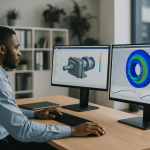
CAE for Renewable Energy: Boosting Wind & Solar Design
CAE for renewable energy is transforming how we design wind turbines and solar panels. Companies can now create more efficient, durable, and cost-effective systems faster than ever.
In this article, you’ll learn how computer-aided engineering (CAE) helps optimize renewable energy designs. We’ll explore its benefits, applications, and tools shaping the future of wind and solar energy.
Why CAE for Renewable Energy Matters
Renewable energy must be efficient to compete with fossil fuels. Poorly designed systems can waste money and energy.
CAE for renewable energy allows engineers to simulate performance before building prototypes. This saves time, cuts costs, and improves efficiency.
Key benefits include:
-
Faster testing of wind and solar designs.
-
Reduced need for physical prototypes.
-
Improved durability and performance prediction.
CAE for Renewable Energy in Wind Turbine Design
How CAE Improves Turbine Blades
Wind turbines must endure extreme weather and loads. CAE for renewable energy helps design blades that maximize energy capture while staying lightweight and strong.
With CAE tools, engineers:
-
Simulate airflow using computational fluid dynamics (CFD).
-
Test blade shapes for optimal aerodynamics.
-
Predict fatigue to avoid costly failures.
Structural Simulation for Towers
Turbine towers face stress from wind, vibration, and weight. CAE can test material choices and structural designs virtually.
This leads to:
-
Safer, longer-lasting towers.
-
Lower material waste.
-
Better performance in diverse climates.
Check out this Siemens Wind Power case study for real-world examples.
CAE for Renewable Energy in Solar Panel Design
Optimizing Solar Panel Efficiency
Solar panels must absorb as much light as possible. CAE for renewable energy enables designers to model light behavior, temperature, and material properties.
Benefits include:
-
Reduced energy loss due to overheating.
-
Optimized cell placement and angles.
-
Faster development of lightweight panels.
Thermal and Structural Testing
Panels often face harsh conditions like snow, wind, and heat. CAE can simulate these stresses before manufacturing.
This reduces:
-
Risk of failure.
-
Maintenance costs.
-
Environmental impact by extending lifespan.
For tips on solar innovation, visit our Energy Efficiency and Performance of Data Centers.
Popular CAE Tools for Renewable Energy
Several CAE platforms drive innovation in wind and solar design:
-
ANSYS – Known for fluid dynamics and structural simulations.
-
SimScale – Cloud-based CAE for fast collaboration.
-
Autodesk Fusion 360 – Combines design and simulation tools.
Each helps teams cut costs, test ideas quickly, and improve energy systems.
Challenges and Opportunities Ahead
While CAE for renewable energy speeds up innovation, challenges remain:
-
High initial software and training costs.
-
Need for skilled engineers to interpret results.
-
Integrating CAE with emerging technologies like AI-driven optimization.
However, as software becomes more accessible, even smaller companies can benefit from CAE-driven renewable solutions.
FAQ: CAE for Renewable Energy
How does CAE reduce costs in renewable energy?
By simulating wind and solar designs, companies avoid expensive prototypes and failures.
Can CAE make wind turbines more efficient?
Yes. It optimizes blade shapes, tower strength, and performance under different wind speeds.
Is CAE worth it for small renewable energy companies?
Cloud-based CAE tools make it affordable for startups and small teams.
Conclusion
CAE for renewable energy is changing how we build wind turbines and solar panels. It helps companies design systems that are efficient, reliable, and affordable.
By using CAE, renewable energy technology can grow faster, making sustainable power more accessible worldwide.
Want to explore how your company can benefit? Visit our How CAE is Enabling the Development of Smart Cities to learn more.
Author Profile

- Online Media & PR Strategist
- Hello there! I'm Online Media & PR Strategist at NeticSpace | Passionate Journalist, Blogger, and SEO Specialist
Latest entries
 Scientific VisualizationOctober 29, 2025Federated Learning Technology in Medical Privacy AI
Scientific VisualizationOctober 29, 2025Federated Learning Technology in Medical Privacy AI Scientific VisualizationOctober 29, 2025Brain Visualization Ethics: Balancing Innovation and Privacy
Scientific VisualizationOctober 29, 2025Brain Visualization Ethics: Balancing Innovation and Privacy Computer Aided-EngineeringOctober 25, 2025How 5G CAE Workflows Transform Remote Engineering
Computer Aided-EngineeringOctober 25, 2025How 5G CAE Workflows Transform Remote Engineering Data AnalyticsOctober 6, 2025Data Analytics Freelancing Success Tips for Professionals
Data AnalyticsOctober 6, 2025Data Analytics Freelancing Success Tips for Professionals

